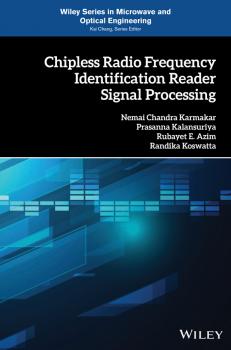MREADZ.COM - много разных книг на любой вкус
Скачивание или чтение онлайн электронных книг.Chipless Radio Frequency Identification Reader Signal Processing
Presents a comprehensive overview and analysis of the recent developments in signal processing for Chipless Radio Frequency Identification Systems This book presents the recent research results on Radio Frequency Identification (RFID) and provides smart signal processing methods for detection, signal integrity, multiple-access and localization, tracking, and collision avoidance in Chipless RFID systems. The book is divided into two sections: The first section discusses techniques for detection and denoising in Chipless RFID systems. These techniques include signal space representation, detection of frequency signatures using UWB impulse radio interrogation, time domain analysis, singularity expansion method for data extraction, and noise reduction and filtering techniques. The second section covers collision and error correction protocols, multi-tag identification through time-frequency analysis, FMCW radar based collision detection and multi-access for Chipless RFID tags as we as localization and tag tracking. Describes the use of UWB impulse radio interrogation to remotely estimate the frequency signature of Chipless RFID tags using the backscatter principle Reviews the collision problem in both chipped and Chipless RFID systems and summarizes the prevailing anti-collision algorithms to address the problem Proposes state-of-the-art multi-access and signal integrity protocols to improve the efficacy of the system in multiple tag reading scenarios Features an industry approach to the integration of various systems of the Chipless RFID reader-integration of physical layers, middleware, and enterprise software Chipless Radio Frequency Identification Reader Signal Processing is primarily written for researchers in the field of RF sensors but can serve as supplementary reading for graduate students and professors in electrical engineering and wireless communications.
Agile Contracts. Creating and Managing Successful Projects with Scrum
A methodologically sophisticated, comprehensive approach to applying the Agile fixed-price contract to IT projects while maximizing customer and supplier relationships «Interesting and necessary for IT managers and IT lawyers.» —Walter J. Jaburek, Dipl.-Ing., Dr. iur., Dr. techn. Approximately 50 percent of software developers use Scrum, an iterative and incremental development method for managing software projects and product or application development, in their work. The benefit of Scrum and other Agile methods is that they can address shifts in a large project that traditional managerial methods cannot. Written by pioneers and leaders in the field of Agile and Scrum, Agile Contracts is the only book dedicated exclusively to the legal, procurement, and project management considerations of Agile contracts. Providing templates, a toolbox, and examples of Agile fixed-price contracts, the book presents an alternative option to fixed-price, time-based, and supply-based contracts—reducing the risk for both the supplier and the customer with a contract that offers the possibility of flux and flexible scenarios as a project progresses. Agile Contracts features in-depth chapter coverage of: The Agile Manifesto of 2001 Agility from the perspective of procurement and the software provider The problems with traditional fixed-price contracts and time material contracts What the Agile fixed-price contract is and how it is set up Tendering based on the Agile fixed-price contract How to negotiate an Agile fixed-price contract Special guidelines for the legal framework of an Agile fixed-price contract Adaptable Scope System The Black Swan scenario Contracts and procedures for the featured methodologies Especially applicable within highly structured business organizations, Agile Contracts is a must-read for project managers, agile practitioners, procurement representatives, and IT lawyers.
Tropical Roots and Tubers. Production, Processing and Technology
Roots and tubers are considered as the most important food crops after cereals and contribute significantly to sustainable development, income generation and food security especially in the tropical regions. The perishable nature of roots and tubers demands appropriate storage conditions at different stages starting from farmers to its final consumers. Because of their highly perishable nature, search for efficient and better methods of preservation/processing have been continuing alongside the developments in different arena. This book covers the processing and technological aspects of root and tuber foods, detailing the production and processing of roots and tubers such as taro, cassava, sweet potato, yam and elephant foot yam. Featuring chapters on anatomy, taxonomy and physiology, molecular and biochemical characterization, GAP, GMP, HACCP, Storage techniques, as well as the latest technological interventions in Taro, Cassava, Sweet potato, yam and Elephant foot Yam.
Process Control Design for Industrial Applications
This book presents the most important methods used for the design of digital controls implemented in industrial applications. The best modelling and identification techniques for dynamical systems are presented as well as the algorithms for the implementation of the modern solutions of process control. The proposed described methods are illustrated by various case studies for the main industrial sectors There exist a number of books related each one to a single type of control, yet usually without comparisons for various industrial sectors. Some other books present modelling and identification methods or signal processing. This book presents the methods to solve all the problems linked to the design of a process control without the need to find additional information.
Bio- and Multifunctional Polymer Architectures. Preparation, Analytical Methods, and Applications
This reference/text addresses concepts and synthetic techniques for the preparation of polymers for state-of-the-art use in biomedicine, synthetic biology, and bionanotechnology.
Host - Pathogen Interaction. Microbial Metabolism, Pathogenicity and Antiinfectives
In light of the rapidity increasing incidence rate of bacterial and fungal infections with multi-resistant pathogens, the metabolic changes associated with host-pathogen interactions offer one of the most promising starting points for developing novel antibiotics. . Part one of this comprehensive guide describes the metabolic adaptation of pathogenic microbes in humans, while part two points to routes for the development of novel antibiotics. This is volume six of the book series on drug discovery in infectious diseases by Paul Selzer.
Ecohydraulics. An Integrated Approach
Ecohydraulics: An Integrated Approachprovides a research level text which highlights recent developments of this emerging and expanding field. With a focus on interdisciplinary research the text examines:– the evolution and scope of ecohydraulics interactions between hydraulics, hydrology, fluvial geomorphology and aquatic ecology the application of habitat modelling in ecohydraulic studies state of the art methodological developments and approaches detailed case studies including fish passage design and the management of environmental flow regimes research needs and the future of ecohydraulics research The contributions offer broad geographic coverage to encapsulate the wide range of approaches, case studies and methods used to conduct ecohydraulics research. The book considers a range of spatial and temporal scales of relevance and aquatic organisms ranging from algae and macrophytes to macroinvertebrates and fish. River management and restoration are also considered in detail, making this volume of direct relevance to those concerned with cutting edge research and its application for water resource management. Aimed at academics and postgraduate researchers in departments of physical geography, earth sciences, environmental science, environmental management, civil engineering, biology, zoology, botany and ecology; Ecohydraulics: An Integrated Approach will be of direct relevance to academics, researchers and professionals working in environmental research organisations, national agencies and consultancies.
Data Fluency. Empowering Your Organization with Effective Data Communication
A dream come true for those looking to improve their data fluency Analytical data is a powerful tool for growing companies, but what good is it if it hides in the shadows? Bring your data to the forefront with effective visualization and communication approaches, and let Data Fluency: Empowering Your Organization with Effective Communication show you the best tools and strategies for getting the job done right. Learn the best practices of data presentation and the ways that reporting and dashboards can help organizations effectively gauge performance, identify areas for improvement, and communicate results. Topics covered in the book include data reporting and communication, audience and user needs, data presentation tools, layout and styling, and common design failures. Those responsible for analytics, reporting, or BI implementation will find a refreshing take on data and visualization in this resource, as will report, data visualization, and dashboard designers. Conquer the challenge of making valuable data approachable and easy to understand Develop unique skills required to shape data to the needs of different audiences Full color book links to bonus content at juiceanalytics.com Written by well-known and highly esteemed authors in the data presentation community Data Fluency: Empowering Your Organization with Effective Communication focuses on user experience, making reports approachable, and presenting data in a compelling, inspiring way. The book helps to dissolve the disconnect between your data and those who might use it and can help make an impact on the people who are most affected by data. Use Data Fluency today to develop the skills necessary to turn data into effective displays for decision-making.
Magnesium Technology 2016
The Magnesium Technology Symposium, the event on which this collection is based, is one of the largest yearly gatherings of magnesium specialists in the world. Papers represent all aspects of the field, ranging from primary production to applications to recycling. Moreover, papers explore everything from basic research findings to industrialization. Magnesium Technology 2016 covers a broad spectrum of current topics, including alloys and their properties; cast products and processing; wrought products and processing; forming, joining, and machining; corrosion and surface finishing; ecology; and structural applications. In addition, there is coverage of new and emerging applications. The collection includes more than 50 papers.
Coupled CFD-DEM Modeling. Formulation, Implementation and Application to Multiphase Flows
Discusses the CFD-DEM method of modeling which combines both the Discrete Element Method and Computational Fluid Dynamics to simulate fluid-particle interactions. Deals with both theoretical and practical concepts of CFD-DEM, its numerical implementation accompanied by a hands-on numerical code in FORTRAN Gives examples of industrial applications









